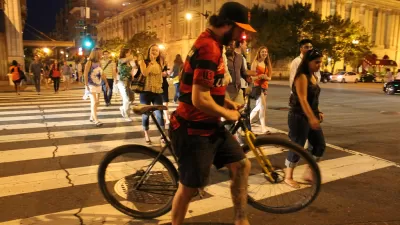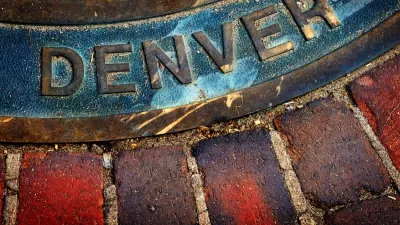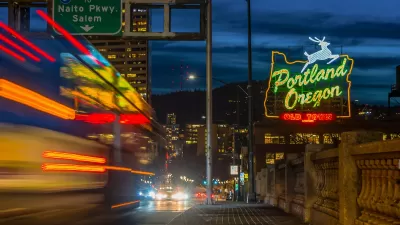Generally speaking, bikes on sidewalks are not a good idea, but a federally funded project in Duluth, Minnesota may cause planners to take a second look at the practice.
Sidewalk widenings in downtowns have generally been done for commercial purposes, e.g., Castro Street streetscape improvement in San Francisco, Burlingame Avenue streetscape improvement in a suburb just south of the city, and California Avenue sidewalk widening in Palo Alto.
Other than adding new bike racks to the widened sidewalks, the idea was to accommodate more pedestrians, add al fresco dining, and generally make the business districts more inviting and walkable. So it was interesting to see a midwestern sidewalk widening project, financed in part with a federal grant, no less, design the project from a multimodal perspective.
"Eight to 10 feet wide and surfacing in strategic locations in Duluth, a transportation evolution is arriving this summer with the advent of what St. Louis County engineers are calling 'super sidewalks,'" reports Forum News Service for the The Bemidji Pioneer.
“They’re wide, so you can have somebody Rollerblading and biking and passing each other with plenty of room,” said Steve Krasaway, resident engineer of a 1.7-mile stretch of Rice Lake Road that’s currently being outfitted with a super sidewalk beginning at Marshall School.
The $1.1 million project is being funded with federal money and transportation sales tax revenue, a county news release said last month.
Improving bicycling safety by ceding roads to cars?
“I’m excited to see this kind of safe, separated place for people to ride bikes,” said Brian Downing, 28, of Duluth, who is a member of the Duluth Bikes advocacy group and the Healthy Duluth Area Coalition
“Everybody can use them at the same time with no conflicts, and it keeps them off the road,” added Krasaway.
Duluth was rated as Bicycle Friendly Community by the Bicycle Alliance of Minnesota in 2014.
A recent Planetizen feature addressed the controversial issue of Bicyclists on Sidewalks: Why They're Not Going Away, and What We Can Do About It."
An earlier post based on an op-ed co-written by PeopleForBikes and America Walks suggested the best way to get bikes off sidewalks was to construct protected bicycle lanes.
FULL STORY: Duluth installing ‘super sidewalks’ for pedestrians, bikers to share

Americans May Be Stuck — But Why?
Americans are moving a lot less than they once did, and that is a problem. While Yoni Applebaum, in his highly-publicized article Stuck, gets the reasons badly wrong, it's still important to ask: why are we moving so much less than before?

Using Old Oil and Gas Wells for Green Energy Storage
Penn State researchers have found that repurposing abandoned oil and gas wells for geothermal-assisted compressed-air energy storage can boost efficiency, reduce environmental risks, and support clean energy and job transitions.

Placekeeping: Setting a New Precedent for City Planners
How a preservation-based approach to redevelopment and urban design can prevent displacement and honor legacy communities.

Study: Maui’s Plan to Convert Vacation Rentals to Long-Term Housing Could Cause Nearly $1 Billion Economic Loss
The plan would reduce visitor accommodation by 25,% resulting in 1,900 jobs lost.

Idaho Data: Unexpected Vehicle Repairs Exacerbate Housing Instability, Eviction Risk
Over 21 percent of clients struggle with transportation barriers.

A Year-Long Investigation On Permanent Supportive Housing
The New York Times reveals what’s working and what’s not in the cornerstone of Housing First.
Urban Design for Planners 1: Software Tools
This six-course series explores essential urban design concepts using open source software and equips planners with the tools they need to participate fully in the urban design process.
Planning for Universal Design
Learn the tools for implementing Universal Design in planning regulations.
Heyer Gruel & Associates PA
City of Moreno Valley
Institute for Housing and Urban Development Studies (IHS)
City of Grandview
Harvard GSD Executive Education
Salt Lake City
NYU Wagner Graduate School of Public Service
City of Cambridge, Maryland





























